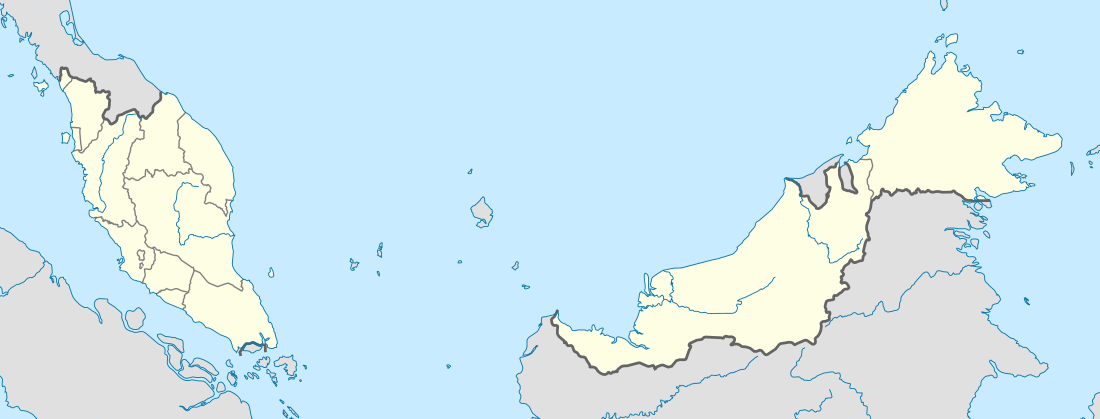Pasir Gudang
| Pasir Gudang | |||
|---|---|---|---|
| Township | |||
| |||
 Pasir Gudang Pasir Gudang shown within Johor Bahru. | |||
| Coordinates: 1°30′10″N 103°56′8″E / 1.50278°N 103.93556°ECoordinates: 1°30′10″N 103°56′8″E / 1.50278°N 103.93556°E | |||
| Country | Malaysia | ||
| State | Johor | ||
| District | Johor Bahru | ||
| Government | |||
| • Local Authority | Pasir Gudang Municipal Council | ||
| • President | Md Za'nal Bin Haji Misran | ||
| Time zone | MST (UTC+8) | ||
| Postcode | 81700 | ||
| Dialling code | +607 | ||
| Police | Pasir Gudang | ||
| Fire | Pasir Gudang | ||
Pasir Gudang is an industrial town located in Johor Bahru District, Johor, Malaysia. It is located at the eastern end of the Johor Bahru metropolitan area. The population is around 100,000 people. It is connected by the 4 lane Pasir Gudang Highway, a trunk road, and a railway line to Johor Bahru. The main industries are transportation and logistics, shipbuilding, petrochemicals and other heavy industries, and oil palm storage and distribution.
It is the site of one of two major power stations in the state of Johor, the Sultan Iskandar Power Station.
History
Established in 1918, Pasir Gudang, which was formerly known as Kampung Pasir Udang, was founded by Long Abu who is believed to have originated from Riau, Indonesia. Four more villages were established by the expanded population of about 83 families.
- Kampung Pasir Gudang Baru. (known as Kampung Pasir Gudang Lama located at TNB Sultan Iskandar Power Station)
- Kampung Sungai Perembi. (currently the Pasir Gudang Police Station)
- Kampung Ulu (currently MSE dockyard)
- Kampung Tengah (currently the Tenaga Nasional area)
- Kampung Hilir.
In 1920, 4 more villages were established :
- Kampung Air Biru (now the port).
- Kampung Pasir Merah (now the port).
- Kampung Pasir Puteh, which is still in existence today.
- Kampung Pulau Tekong, now the territory of Singapore.
The name Pasir Gudang originated from the existence of a sand mine at Kampung Ulu. Sand or 'pasir' in Malay are dug and stocked in sand pits/stores or 'gudang' in Malay, to be exported to Singapore, hence the name 'Pasir Gudang'.
The surrounding areas further inland were developed in the mid-19th century by Chinese travellers of the Teochew clan. Issuance of the 'river deed' by the Sultan of Johore allowed them to develop the Kangkar Masai, Kangkar Plentong and Kangkar Lunchu areas under riverheads known as 'kangchus'. It was on these riverbeds that they cultivated catechu and black pepper. Falling catechu and black pepper prices forced some estate owners to cultivate pineapples.
The introduction of rubber into Malaysia in the early 20th century resulted in the opening of big estates by the British and Singaporean cultivators. Up till 1916, six estates covering an area of 15,000 acres (61 km²) were opened in the Mukim of Plentong. In 1916, Kampung Pasir Gudang became the centre for Police, Customs and opium-control besides being a centre for the 'penghulu' of the Mukim of Pasir Gudang. The formation of estates had also resulted in influx of labourers from China and India.
The Japanese occupation during the Second World War and guerrilla movements after the war did not have much effect on the agricultural activities here. Under the Emergency Law in the 1950s, new villages were set up at Plentong, Masai, Johor and Pasir Gudang. The estate labourers were either placed in these new villages or at guarded estate barracks.
Land schemes under the FELDA scheme were founded in Ban Foo, Plentong Baru and Felda Cahaya Baru after 1969. To further develop Johor, the State Government further took the estate lands to be converted into industrial and housing areas to the develop Pasir Gudang into an industrial area. Establishment of the Johore Port in 1977 was seen as a reaction to counter the entrepôt hub in Singapore.
Administration
Pasir Gudang is administered by the Pasir Gudang Local Authority, or Pihak Berkuasa Tempatan Pasir Gudang, a subsidiary of Johor Corporation. It is the first local authority in Malaysia that was privatised, although Johor Corporation is the investment arm of the Johor State Government.
Pasir Gudang Local Authority receives no financial support from either the state or federal government.
On 1 July 2007, this agency was granted municipal status and changed its name to Pasir Gudang Municipal Council.
Tourist and holiday attraction
Pasir Gudang Kite Museum is located here, on top of Kite Hill. It is the first kite museum in Malaysia and has a unique working windmill whose mechanism works to generate enough electricity to supply the daily needs of the museum. It also hosts the annual Pasir Gudang International Kite Festival.
The 3.86 km Johor Racing Circuit is located here, which formerly hosted one of the legs of the World Motorcycle Championship, being one of only two legs held in Asia.
Pasir Gudang has one golf course, the Tanjung Puteri Golf Resort. It has an area of 8.3 km² and 3 courses named Plantation, Village and Straits.
See also
External links
| Wikimedia Commons has media related to Pasir Gudang. |
| Wikivoyage has a travel guide for Pasir Gudang. |
- Pasir Gudang Local Authority
- Photos of Pasir Gudang International Kite Festival
- Photos of Pasir Gudang Kite Festival 2005, taken by a Canon PowerShot S70 camera attached to a flying kite
- Johor Circuit at Pasir Gudang

